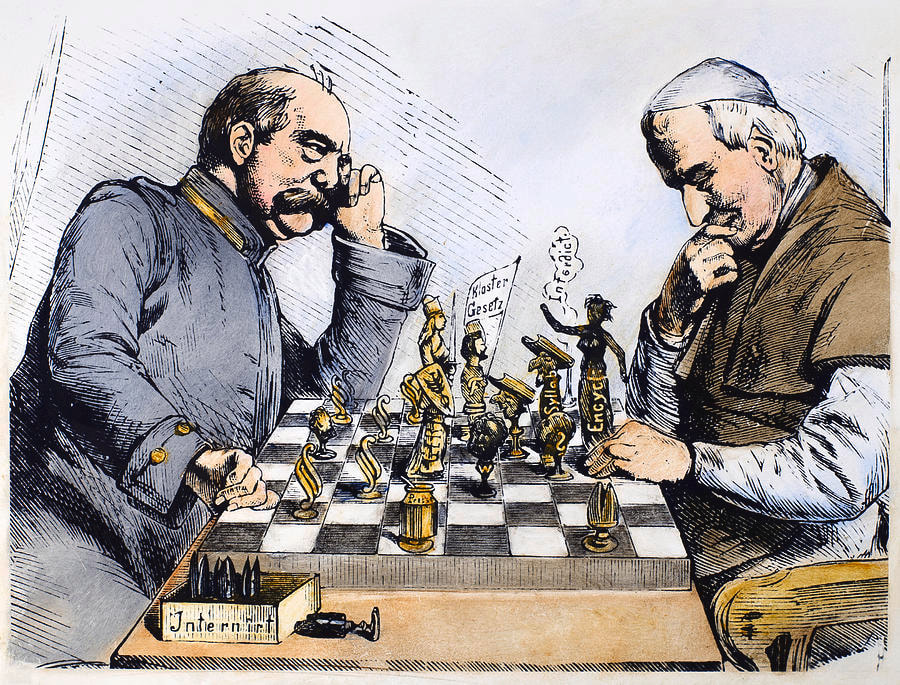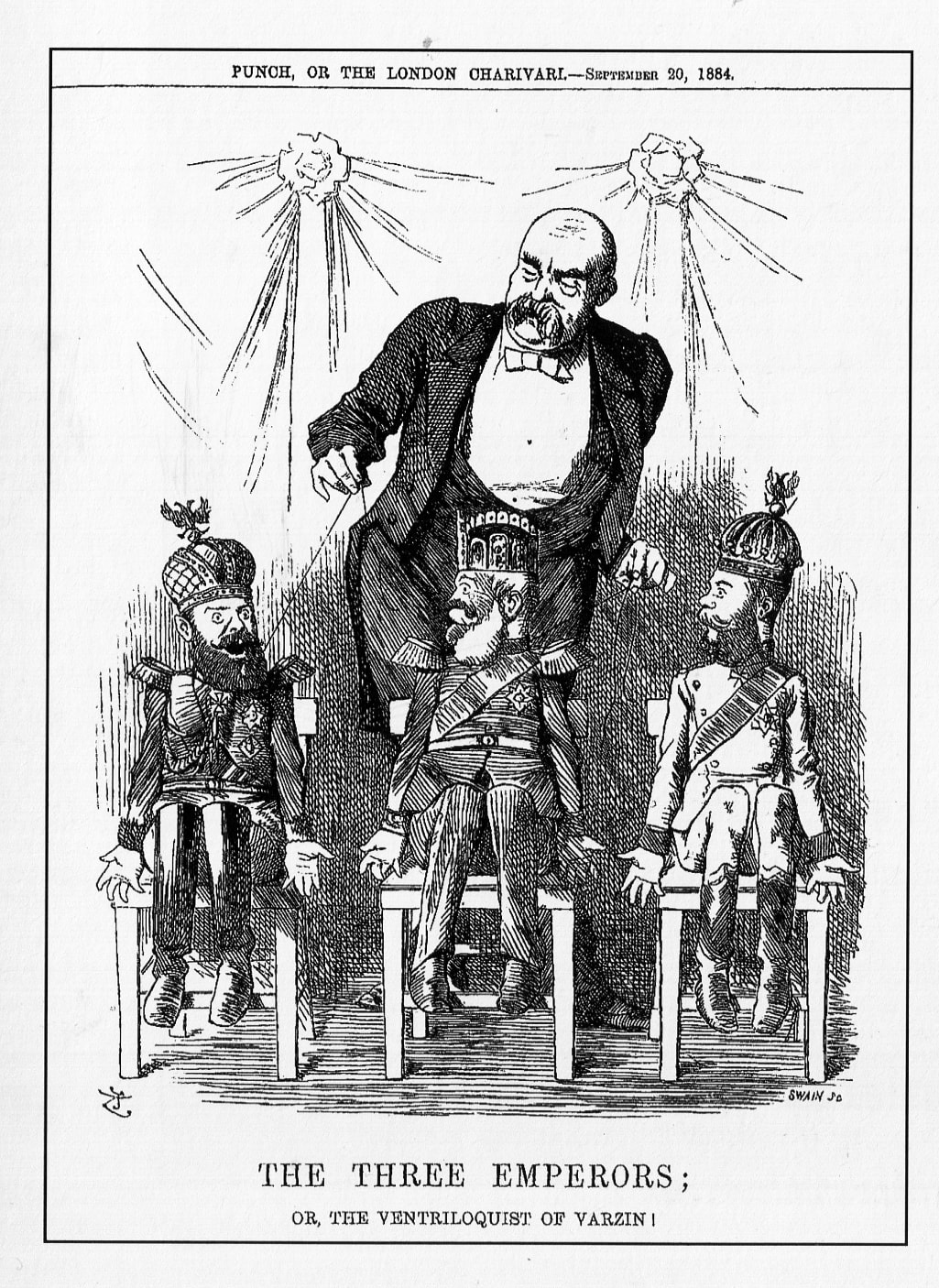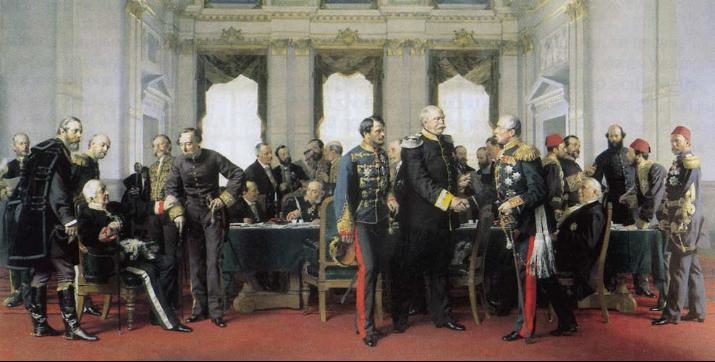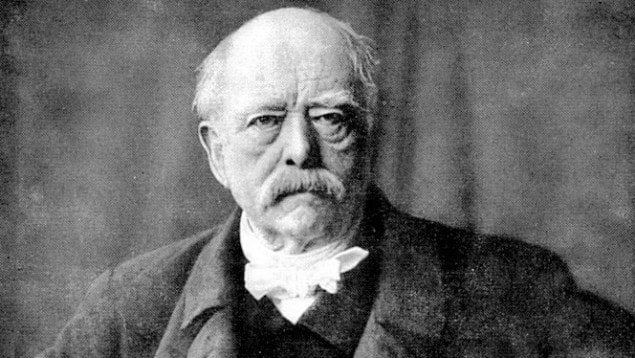Lesson 8 - The German Empire before the First World War
The syllabus is unusually creative for this final part of Matu 5, it states 'situer la constitution et l’histoire de l’empire allemand comme "démocratie avec un grand point d’interrogation"; expliquer le système des alliances de Bismarck et les débuts de l’Etat social allemand. '
The German Empire, a democracy? This question mark is not big enough...
The German Empire, a democracy? This question mark is not big enough...
|
Why study Germany and not any other European country at this time? I can think of four reasons. Firstly, much of what happens in Germany at this time also happens elsewhere and Germany is as good an example as anywhere. Secondly, Germany is the most powerful European power economically and militarily before the First World War. Thirdly, Bismarck was an exceptional statesman and diplomat. And finally, Germany plays a significant role in causing the First World War and what happens in Germany before 1914 helps us to understand why.
|
The constitution.
The German Empire was an extension of the North German Confederation. Eighteen states, four kingdoms as well as the free cities of Hamburg, Bremen, and Lübeck were brought together in a federal structure. Alsace-Lorraine was administered as a separate territory.
The German Empire was an extension of the North German Confederation. Eighteen states, four kingdoms as well as the free cities of Hamburg, Bremen, and Lübeck were brought together in a federal structure. Alsace-Lorraine was administered as a separate territory.
|
The executive consisted of the Emperor, the Chancellor and the cabinet. The Bundesrat (upper house) was based on state representation, while the Reichstag (lower house) was based on representation by population selected by universal adult male suffrage. The Reichstag could debate policy and approve budgets but this was a very limited power. The Bundesrat could initiate and debate legislation. While on the surface there were a number of democratic features in this constitution, especially by 19th-century standards, the executive retained a great deal of power and was responsible to the Crown rather than to the assembly. Within the executive, the Crown possessed immense power, from commanding the military, to interpreting the constitution. The German Empire was in theory a constitutional monarchy, but that constitution vested the majority of power in the monarch. So yes, not really democracy and a very big question mark.
|
1871-1878: Bismarck, Liberals and Kulturkampf
Throughout the 1870s the National Liberal party was the strongest party in the Reichstag and Bismarck set out to work with them. While such co-operation may seem unlikely, both Bismarck and the liberals wanted a more centralised and unified state. For Bismarck such control was an extension of the unity project. For the liberals, such centralisation and rationalisation was necessary for a modern industrial society. They agreed on creating national bank, the adoption of a single currency, the rationalisation of commercial and criminal law across the Reich and free trade. Something else they agreed on was the weakening of the influence of the Catholic Church.
Throughout the 1870s the National Liberal party was the strongest party in the Reichstag and Bismarck set out to work with them. While such co-operation may seem unlikely, both Bismarck and the liberals wanted a more centralised and unified state. For Bismarck such control was an extension of the unity project. For the liberals, such centralisation and rationalisation was necessary for a modern industrial society. They agreed on creating national bank, the adoption of a single currency, the rationalisation of commercial and criminal law across the Reich and free trade. Something else they agreed on was the weakening of the influence of the Catholic Church.
|
The Empire contained a significant Catholic minority, especially in the southern states and this interest group formed the core of the Centre Party that took seats in the Reichstag. Liberals were ideologically opposed to any role for the Church, any Church, in affairs of state, infringing as they saw it on natural individual rights. For Bismarck it had nothing to do with individual rights. He believed Catholics within the Reich were Germans first and as such owed primary allegiance to the Crown, not to Rome. When, in 1870, Pope Pius IX introduced the doctrine of Papal Infallibility, he seemed to be demanding the opposite from German Catholics and as such posed a direct challenge to the authority of the German state. To meet this challenge, Bismarck declared a legislative war against the Catholic Church in Germany, what liberals called a Kulturkampf a "cultural war" between the Church and the state. Schools were brought under the authority of the state. As in Switzerland the Jesuits were essentially expelled from Germany.
|
When the Vatican responded by forbidding Catholics from observing these laws on the threat of excommunication, the German government outlawed most monastic orders within the Reich, imprisoning and exiling those who chose the authority of Rome over the German state.
1878-1890: Bismarck and the Centre (Catholic) Party
By 1878 the situation in Germany had changed. Despite the persecution of Catholics, the conservative Centre Party was doing well in the elections. In addition, a worldwide depression and a flood of American and British goods into German markets meant that protectionism, rather than free trade, had become popular with Germany's major industrialists. The Centre Party was strongly protectionist and tariffs would also bring money into the state. Most importantly Bismarck was now looking for conservative ally to help him fight the rising threat of socialism. The rise of this working class movement and its revolutionary threat to capitalism became an obsession for the ruling classes across Europe. After 1878 the abrupt end to the Kulturkampf allowed Bismarck to focus the repressive power of the state on Germany's socialists. Two failed attempts on the Kaiser Wilhelm's life gave Bismarck the reasons he needed. Socialist newspapers were banned and meetings outlawed. The antisocialist laws were renewed regularly until 1890 by which time the growth of the German socialist movement had been curtailed. But Bismarck did not rely on simple banning and censorship to eliminate socialism from German political and social life. He also introduced a series of paternalistic laws designed to provide a basic social safety net for German workers. This net included a modest state pension plan, medical insurance and insurance against disability caused by industrial accidents.
By 1878 the situation in Germany had changed. Despite the persecution of Catholics, the conservative Centre Party was doing well in the elections. In addition, a worldwide depression and a flood of American and British goods into German markets meant that protectionism, rather than free trade, had become popular with Germany's major industrialists. The Centre Party was strongly protectionist and tariffs would also bring money into the state. Most importantly Bismarck was now looking for conservative ally to help him fight the rising threat of socialism. The rise of this working class movement and its revolutionary threat to capitalism became an obsession for the ruling classes across Europe. After 1878 the abrupt end to the Kulturkampf allowed Bismarck to focus the repressive power of the state on Germany's socialists. Two failed attempts on the Kaiser Wilhelm's life gave Bismarck the reasons he needed. Socialist newspapers were banned and meetings outlawed. The antisocialist laws were renewed regularly until 1890 by which time the growth of the German socialist movement had been curtailed. But Bismarck did not rely on simple banning and censorship to eliminate socialism from German political and social life. He also introduced a series of paternalistic laws designed to provide a basic social safety net for German workers. This net included a modest state pension plan, medical insurance and insurance against disability caused by industrial accidents.
|
Foreign Policy
After 1871 Bismarck's diplomacy was focused on the maintenance of the new European order he had created. Central to his plans was keeping France isolated diplomatically. The Three Emperors League created by Bismarck in 1873 brought Tsar Alexander II, Emperor Franz Joseph I and Kaiser Wilhelm I together in a vague agreement to co-operate in preserving the general European peace. (What is the meaning of the cartoon opposite? Clue - Bismarck's estates were in Varzin, Warcino in modern day Poland) As France recovered after the shock of 1870-1, the threat to Bismarck's new European order became apparent. In reality the Three Emperor's League did nothing to limit French ambitions to reclaim her lost territories. The continued decline of the Ottoman Empire in the Balkans provided another test of the stability of the European peace. The southern European slavic nations' desire for independence from Turkish rule encouraged the support of Russia who declared war on the Ottomans in 1877. Austria and Britain prepared to defend the Ottoman Empire. The Austrians saw an opportunity to their south to make up for their northern losses to the Prussians and the British feared Russian ambitions would threaten access to their Suez canal. Bismarck had no interest in the Balkans but he feared war would destroy his European order. He invited the powers to a Congress at Berlin in June 1878 which successfully avoided war for now, but also lay the foundations for the war that finally would break out in 1914. (Matu 7) |
The long-term causes of the First World War
The settlement that emerged out of the Congress of Berlin did not answer the 'Eastern Question' which the decline of the Ottoman Empire had revealed. The Russians made some gains at Berlin, including independence for her slavic allies Serbia and Montenegro, but the Tsar was disappointed not to have achieved more and blamed Bismarck for this. In turn, Bismarck established a closer 'Dual Alliance' with the Austrians in 1879 and this was expanded into the Triple Alliance when Italy joined in 1882. His desire to keep the Russians on board survived the collapse of the Three Emperors League in 1886, when in 1887 Bismarck negotiated a secret 'Reinsurance Treaty' with the Russians which guaranteed the neutrality of either side in the event of war with a third power.
Whilst the rest of Europe 'scrambled for Africa', Bismarck's Germany expressed no apparent interest in imperial conquest. (Matu 6) But when disputes between countries threatened European stability, Bismarck intervened and in 1884 once again called an international conference in Berlin to resolve the disputes (see image below). The European powers divided Africa up amongst themselves and Germany acquired significant territories in south west Africa and a collection of Pacific islands. Once again, war had been avoided.
The settlement that emerged out of the Congress of Berlin did not answer the 'Eastern Question' which the decline of the Ottoman Empire had revealed. The Russians made some gains at Berlin, including independence for her slavic allies Serbia and Montenegro, but the Tsar was disappointed not to have achieved more and blamed Bismarck for this. In turn, Bismarck established a closer 'Dual Alliance' with the Austrians in 1879 and this was expanded into the Triple Alliance when Italy joined in 1882. His desire to keep the Russians on board survived the collapse of the Three Emperors League in 1886, when in 1887 Bismarck negotiated a secret 'Reinsurance Treaty' with the Russians which guaranteed the neutrality of either side in the event of war with a third power.
Whilst the rest of Europe 'scrambled for Africa', Bismarck's Germany expressed no apparent interest in imperial conquest. (Matu 6) But when disputes between countries threatened European stability, Bismarck intervened and in 1884 once again called an international conference in Berlin to resolve the disputes (see image below). The European powers divided Africa up amongst themselves and Germany acquired significant territories in south west Africa and a collection of Pacific islands. Once again, war had been avoided.
March 1888, Kaiser Wilhelm died. He was briefly succeeded by his son Friedrich III who also died within the year. This left the throne to 29-year-old Wilhelm II. Kaiser Wilhelm II and Bismarck soon disagreed on both domestic and foreign policy. The Kaiser opposed Bismarck's careful foreign policy, wishing instead to enlarge Germany's empire or "place in the sun". A series of disputes over domestic policy finally led to Bismarck's resignation in March 1890.
|
Activities
1. How democratic was the German constitution of 1871? 2. Explain how and why in the period 1871-1878 Bismarck conducted a Kulturkampf . 3. Explain how in the period 1878-1890 Bismarck sought to control the socialists. 4. Explain the role of the following in the diplomatic plans of Bismarck: a) The Three Emperors League 1873, b) The Congress of Berlin 1878 and c) The Treaty of Berlin 1884-5. |






